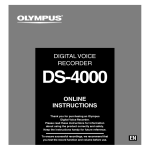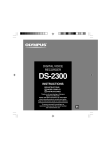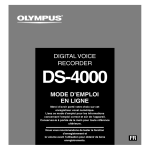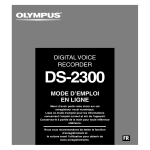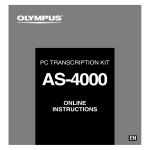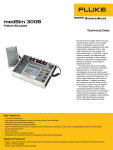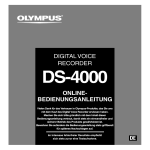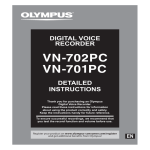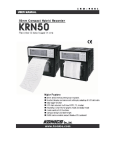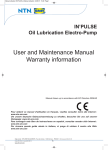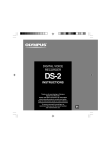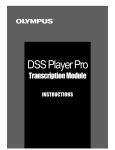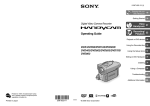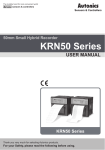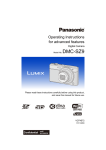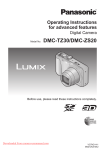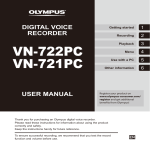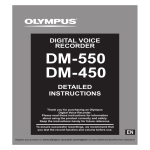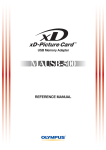Download DS-3300 Instruction Manual (English)
Transcript
DIGITAL VOICE
RECORDER
DS-3300
ONLINE
INSTRUCTIONS
Thank you for purchasing an Olympus
Digital Voice Recorder.
Please read these instructions for information
about using the product correctly and safely.
Keep the instructions handy for future reference.
To ensure successful recordings, we recommend that
you test the record function and volume before use.
EN
1
Table of Contents
Table of Contents ..................................... 2
Using the Variable Control
Safe and Proper Usage ........................... 4
Voice Actuator (VCVA) .................... 29
General Precautions ................................ 5
Hands-free Recording ........................... 30
1 Getting Started
Main Features .......................................... 9
xD-Picture Card ..................................... 10
Identification of Parts ............................. 11
Recording Monitor ................................. 30
Playing ................................................... 31
Erasing ................................................... 33
3 Other Functions
Installing Batteries ................................. 13
Menu List ............................................... 37
Charging Battery ................................... 15
Learning to Use the Menu ..................... 38
Information Regarding Rechargeable
Locking Files (LOCK) ............................ 39
Batteries .......................................... 16
Index Marks ........................................... 40
Turning ON the Recorder ...................... 17
LCD Display Information ....................... 41
Power Save Mode .................................. 17
Setting Priority Levels ............................ 43
Dealer Option Items .............................. 18
Setting Job Data .................................... 44
CUSTOM Button (Programmable) ........ 18
Setting Option Item ................................ 46
Setting Time/Date (TIME&DATE) .......... 19
Formatting the Card (FORMAT) ............ 47
Inserting and Ejecting a Card ............... 21
Hold ........................................................ 49
2 Basic Operations
Recording .............................................. 23
4 Preparation Before Using
DSS Player
Microphone Sensitivity (MIC SENSE) ... 27
DSS Player Software ............................. 50
Recording Modes (REC MODE) ........... 28
Installing DSS Player Software ............. 52
Uninstalling DSS Player Software ......... 53
2
Using Online Help ................................. 54
Connection to Your PC .......................... 55
Running DSS Player .............................. 58
Window Names ...................................... 60
5 Managing Files on Your PC
Download Dictation Files
6 Using the Recorder as a
Reader / Writer
1
Using the Recorder as a
2
Reader/Writer .................................. 88
3
7 Other Information
Alarm Message List ............................... 89
from the Recorder ........................... 61
Troubleshooting ..................................... 90
Playing a Dictation File .......................... 63
Accessories (Optional) .......................... 91
Upload Dictation Files to the Recorder .... 64
Specifications ........................................ 92
Direct Recording/Editing on PC ............ 65
Technical Assistance and Support ........ 93
4
5
6
Changing User ID (Author ID) ............... 66
Changing a Folder Name ...................... 67
Editing File Comments .......................... 67
7
Using Voice Recognition
Software (Optional) ....................... 68
Joining Files ........................................... 72
Splitting Files ......................................... 74
USB Microphone/USB Speaker ............ 76
Sending Dictation Files/
Receiving Document Files .............. 77
3
Safe and Proper Usage
Before using your new recorder, read this
manual carefully to ensure that you know
how to operate it safely and correctly.
Keep this manual in an easily accessible
location for future reference.
Important Safety Precautions
Certain symbols are used in the user’s
manual and on this product to help
protect users, their surroundings, and
their property from possible injury or
damage. Please familiarize yourself with
the following definitions and meanings
for each symbol before reading the
precautions.
Danger
Signifies danger which
may result in serious
injury or death.
Indicates items or actions
which may cause serious
Warning injury or death.
Indicates items or actions
which may result in damage
Caution or personal injury.
4
Symbols prohibiting a specific action
Prohibited
Do not
disassemble
Symbols requiring a specific action
Mandatory
Unplug from
power outlet
Convention Used In this Manual
• The word “card” is used to refer to the xDpicture Card.
• The word “DSS Player” is used to refer to
the DSS Player Pro Dictation Module in
Windows environment and DSS Player in
Apple Macintosh environment.
• The Notes at the bottom of a page are used
for additional information, exceptions, or
related events.
• Words in uppercase form such as PLAY or
REC are used to describe a function,
button, or switch position on the recorder.
• The icon
indicates that feature or
setting can be modified by Professional
Olympus Authorized Dealer only.
General Precautions
● Do not leave the recorder in hot, humid
locations such as inside a closed
automobile under direct sunlight or on
the beach in the summer.
● Do not store the recorder in places
exposed to excessive moisture or dust.
● Do not use organic solvents such as
alcohol and lacquer thinner to clean the
unit.
● Do not place the recorder on top of or
near electric appliances such as TVs or
refrigerators.
● Avoid recording or playing back near
cellular phones or other wireless
equipment, as they may cause
interference and noise. If you
experience noise, move to another
place, or move the recorder further
away from such equipment.
● Avoid sand or dirt. These can cause
irreparable damage.
● Avoid strong vibrations or shocks.
● Do not disassemble, repair or modify
the unit yourself.
● Do not operate the unit while operating
a vehicle (such as a bicycle,
motorcycle, or go-cart).
● Keep the unit out of the reach of
children.
<Warning regarding data loss>
Recorded content in memory may be
destroyed or erased by operating
mistakes, unit malfunction, or during
repair work.
It is recommended to back up and save
important content to other media such as
a computer hard disk.
Batteries/Rechargeable
Battery Pack (BR402)
Danger
• Do not solder lead wires or terminals
directly onto a battery or modify it.
• Do not connect the
and
terminals
together. This may cause fire,
overheating or electric shock.
• When carrying or storing the battery
(BR402), be sure to put it in the provided
case to protect its terminals. Do not carry
or store the battery with any metal objects
(such as key rings). If this warning is not
followed, fire, overheating or electric
shock may occur.
• Do not connect the batteries directly to
a power outlet or a cigarette lighter of
an automobile.
• Do not insert the batteries with their
and
terminals reversed.
• If any liquid from a battery gets into your
eyes, promptly wash it off with clean
water and consult your doctor at once.
• There is a hole from which gas escapes
on the terminal. Do not cover or block
it (BR402).
Warning
• Batteries should never be exposed to
flame, heated, short-circuited or
disassembled.
• Do not attempt to recharge alkaline,
lithium or any other non-rechargeable
batteries.
• Never use any battery with a torn or
cracked outer cover.
5
General Precautions
• Keep batteries out of the reach of
children.
• If you notice anything unusual when
using this product such as abnormal
noise, heat, smoke, or a burning odor:
1 remove the batteries immediately while
being careful not to burn yourself, and;
2 call your dealer or local Olympus
representative for service.
• Do not expose the rechargeable
batteries to water. Do not allow water to
contact the terminals.
• Do not remove or damage the battery
insulating sheet.
• Do not use the batteries if you find
something wrong with them such as
leakage, color change or deformity.
• Unplug the charger if the charging is still
incomplete after the specified time it
should take.
• Should any battery liquid get on skin or
clothing, promptly wash it off with clean
water.
• Keep batteries away from fire.
• When using new batteries, or batteries
which have not been used for a long
time, be sure to recharge them even if
they were only used for a short period
of time.
Battery Charger (Cradle)
Danger
• Do not attempt to use this charger
with anything other than Olympus
Ni-MH batteries. Using it in
combination with other batteries
may cause fire, explosion, leakage
or overheating.
• Do not put the charger in water.
Using it when wet or in a humid area
(such as a bathroom) may cause
fire, overheating or electric shock.
• Do not use the charger with
batteries that have been
inserted with their
and
terminals reversed. This may
cause fire, explosion, leakage,
overheating or damage to
batteries.
Caution
6
• BR402 rechargeable batteries are
exclusively for use with Olympus digital
voice recorder DS-3300. Do not use
them in combination with other
equipment.
• Do not subject batteries to strong
shocks.
• Do not use with other types of batteries,
or with batteries that have different
voltages or brand names.
• When using more than two batteries,
charge them at the same time.
Do not
disassemble
• Never modify or disassemble
the charger. This may cause
fire, overheating, electric
shock or injury.
Warning
• Do not use the batteries if you
find something wrong with
them such as deformity or
leakage. This may cause
explosion or overheating.
• Do not insert metal wires or
similar objects. This may
cause fire, overheating or
electric shock.
• If charging does not finish (or
if the charge indicator light
does not go off) after three
hours, the charger may break.
If this occurs, disconnect the
power plug and consult your
nearest Olympus dealer or
customer support center.
• Keep out of the reach of
children. Do not let children
use this product without adult
supervision.
• Do not use or store the
charger in/on an unstable
place, such as a television set,
etc. If it falls, it may cause
injury or break.
Caution
• If charging is not completed (if
the charging indicator is not
turned off) after 3 hours, plug
the power-supply cord out.
Contact the store of purchase
or Olympus Service Station
for repair since it may be a
malfunction.
• Be sure to charge batteries
within the temperature range
of 0°C - 40°C/32°F - 104°F. If
not, there may be explosion,
fire, leakage or damage to
batteries.
• Do not put anything heavy on
the charger or leave it in an
unstable position or in a
humid place. This may cause
explosion, fire, leakage,
overheating, electric shock or
injury.
• Do not touch the charger for
too long when using it. This
may cause a serious lowtemperature burn.
AC Adapter
Danger
• Be sure to use the charger with
the proper voltage (AC 100 - 240
V). Using it with other voltage
levels may cause fire, explosion,
overheating, electric shock or
injury.
Unplug from
power outlet
• For safety, be sure to unplug the
charger from the outlet before
performing maintenance or
cleaning. Also, never plug in or
disconnect the power plug with a
wet hand. This may cause electric
shock or injury.
Warning
• Do not attempt to disassemble, repair
or modify the AC adapter in any way.
• Keep foreign objects including water,
metal, or flammable substances from
getting inside the product.
7
General Precautions
• Do not moisten the AC adapter or touch
it with a wet hand.
• Do not use the AC adapter in the vicinity
of flammable gas (including gasoline,
benzine and lacquer thinner).
In case
• ... the internal parts of the AC adapter
are exposed because it has been
dropped or otherwise damaged:
• ... the AC adapter is dropped in water,
or if water, metal flammable substances
or other foreign objects get inside it:
• ... you notice anything unusual when
using the AC adapter such as abnormal
noise, heat, smoke, or a burning odor:
1 do not touch any of the exposed parts;
2 immediately disconnect the power
supply plug from the power outlet, and;
3 call your dealer or local Olympus
representative for servicing. Continued
use of the AC adapter under these
circumstances could result in electric
shock, fire or injury.
Caution
• Do not use the charger if the
power plug is damaged or the
plug is not completely
connected to the outlet. This
may cause fire, overheating,
electric shock, short circuit or
damage.
Unplug from
power outlet
8
• Unplug the AC Adapter from
AC outlet when not using. If
this precaution is not
followed, fire, overheating or
electric shock may occur.
• Make sure to hold the plug
when removing the power
plug from the outlet. Do not
bend the cord excessively or
put a heavy object on it. This
may cause fire, overheating,
electric shock or damage.
• If something appears to be
wrong with the charger,
unplug the charger from the
outlet and consult your
nearest service center. Using
the charger may cause fire,
overheating, electric shock or
injury.
• Do not use or keep the charger
in very hot places, such as in
direct sunlight, in a closed car
on a sunny day, near a heater,
on an electric carpet, etc. Do not
use the charger if something is
covering it (such as a blanket).
This may cause fire, explosion,
leakage or overheating.
Main Features
● The recorder has multi programmable
button (CUSTOM) (☞ P.18).
● Recording and storing voice in DSS
format.
● Two recording modes, SP (Standard
Playback) mode or LP (Long Playback)
mode (☞ P.28).
● Five folders and up to 199 files/folder, for
a maximum of 995 recordings (☞ P.23).
IBM and PC/AT are the trademarks or registered
trademarks of International Business Machines
Corporation.
Microsoft and Windows are registered trademarks
of Microsoft Corporation.
Apple, Macintosh, iMac, eMac, Mac, and
PowerMac are trademarks or registered
trademarks of Apple Computer, Inc.
Intel and Pentium are registered trademarks of Intel
Corporation.
1
Main Features
● Dual function cradle, docking station, for
recharging of the optional Ni-MH
Rechargeable Battery Pack (BR402)
(☞ P.14)*1 and for downloading data from
the recorder to a PC (☞ P.61).
Adobe and Acrobat Reader are registered
trademarks of Adobe Systems Incorporated.
Other product and brand names mentioned herein
may be the trademarks or registered trademarks
of their respective owners.
● Built-in Variable Control Voice Actuator
(VCVA) function (☞ P.29).
● USB Audio Device, recorder can be used
as a USB microphone or USB speaker
when connected to a PC (☞ P.76).*2
● Large LCD screen with backlight.
● Multi-level priority setting (☞ P.43).
● DSS Player software included (☞ P.50).
● Hands-free recording function when used with
the optional foot switch (RS25/26) (☞ P.30).
*1 Available only with the optional Ni-MH Rechargeable
Battery Pack (BR402).
*2 Do not use with Windows 98 as computer operation may
become unstable.
9
xD-Picture Card
The xD-Picture Card is a removable recording media.
1
xD-Picture Card
Compatible Cards
The removable card can be used to store different
kind of data. Since the card has larger memory
capacity than a diskette, it can be used to transfer
data between different PCs. The recorder supports
cards with memory capacity between 16 to 512 MB.
1 Index area
You can write
down the card’s
contents.
2 Contact area
Comes into
contact with the
recorder’s signal
read contacts.
Memory Sizes of Cards and Approximate Recording Times*1
Memory Size
16MB
SP Mode
LP Mode
2 hr. 35 min.
5 hr. 30 min.
32MB
5 hr. 13 min.
11 hr. 00 min.
64MB
10 hr. 25 min.
22 hr. 20 min.
128MB
20 hr. 55 min.
44 hr. 45 min.
256MB
42 hr. 00 min.
89 hr. 40 min.
512MB
84 hr. 05 min.
179 hr. 30 min.*2
*1: Available recording time for one continuous file.
Available recording time may be shorter if
many short recordings are made.
*2: Total recording time of two files. The maximum
recording time per file is 99 hours.
..............................................................................................................................................................
Notes
10
• When initializing (formatting) a card, confirm that no necessary data is stored on the card
beforehand. Initialization completely erases the existing data on the card.
• Cards used in a recorder must be formatted in the same recorder first unless formatted with a
CAMEDIA series Olympus digital camera. Card may not perform as expected when formatted by a
different device.
• The card has a service life. When reaching the end of its life, writing or erasing data on the card will be
disabled. In this case, replace the card.
• If you use a PC card adapter compatible with the card to save or delete some data on the card, the
maximum recording time on the card may be decreased. To recover the original recording time, initialize/
format the card in the recorder.
• Olympus will not be held liable for any data corruption or loss due to misuse of the media card.
Identification of Parts
1
2
3
%
$
#
@
!
4
5
6
7
8
*
(
)
-
Identification of Parts
&
^
1
=
9
0
q
w
1 EAR (Earphone) jack
2 MIC (Microphone) jack
3 Built-in microphone
4 NEW button
5 HOLD switch
6 REC (Record) button
7 REW (Rewind) button
8 FF (Fast Forward) button
9 INDEX button
0 FOLDER/MENU button
! Built-in speaker
@ STOP button
# PLAY button
$ ERASE button
% CUSTOM button
(Programmable)
^ Display (LCD panel)
& Record/Play indicator lamp
* POWER (ON/OFF) switch
( VOLUME (+) button
) VOLUME (–) button
- Card cover
= Card cover lock
q Battery cover
w PC (USB) terminal/Cradle
attachment point
11
Identification of Parts
Display (LCD Panel)
1
Identification of Parts
1
0
9
8
2
3
4
5
6
7
1 Battery indicator
2 Folder
3 Priority indicator
4 Current file number
5 Total number of recorded files in
the folder
6 Erase lock indicator
7 Character Information display
8 Microphone sensitivity display
9 VCVA (Variable Control Voice
Actuator) indicator
0 Record mode indicator
12
Installing Batteries
AAA alkaline batteries
2
1
2
3
Insert two AAA batteries, observing the correct
polarity.
Close the battery cover completely.
1
Installing Batteries
1
Lightly press down on the arrow and slide the
battery cover open.
Replacing batteries
The battery indicator on the display changes as the batteries
lose power.
→
→
→
3
When
appears on the display, replace the batteries
as soon as possible.
When the batteries are too weak, the recorder shuts down
and “BATTERY LOW” appears on the display.
..............................................................................................................................................................
Notes
• Be sure to turn OFF the recorder before replacing the batteries. Removing the batteries while the
recorder is in use may corrupt the card. If you are recording into a file and the batteries run out, you will
lose your currently recorded file since the file header will not be written. It is crucial to replace the batteries
when one hash mark in shown in the battery icon.
• Be sure to replace both batteries at the same time.
• Never mix old and new batteries, or batteries of different types and/or brands.
• If it takes longer than 1 minute to replace dead batteries, you may have to reset the time when you load
new batteries.
• Remove the batteries if you are not going to use the recorder for an extended period of time.
13
Installing Batteries
Ni-MH Rechargeable Battery Pack (BR402) (Optional)
1
Installing Batteries
1
2
An optional Ni-MH Rechargeable Battery from Olympus can
be used for the recorder.
1
2
3
Lightly press down on the arrow and slide the
battery cover open.
Insert Ni-MH Rechargeable Battery Pack,
observing the correct polarity.
Close the battery cover completely.
The battery needs to be charged when you use the recorder
for the first time after purchase (☞P.15).
Recharging battery
3
The battery indicator on the display changes as the battery
loose power.
→
→
→
When
appears on the display, charge the battery as soon
as possible.
When the battery is too weak, the recorder shuts down and
“BATTERY LOW” appears on the display.
..............................................................................................................................................................
Notes
• The Olympus Ni-MH Rechargeable Battery Pack (BR402) is sold separately.
• Removing the battery pack while the recorder is in use may corrupt the file. If you are recording into a file
and the battery run out, you will lose your currently recorded file since the file header will not be written. It
is crucial to charge the battery once you see only one hash mark in the battery icon.
• Remove the battery pack if you are not going to use the recorder for an extended period of time.
14
Charging Battery
AC cable
AC adapter
1
7AC) or USB cable to the cradle.
2
Turn ON the recorder and set it vertically
in the cradle.
For connection procedures, see P.57.
When using the adapter for charging, connect the
power plug to the charger’s AC connector.
AC
connector
1
Charging Battery
You can charge the Ni-MH Rechargeable Battery Pack (BR402) in the recorder when you set the recorder
in the cradle. The battery is usually shipped partially charged. You need to charge the battery before first
use.
Connect the optional AC adapter (A511/DA511/D-7AC (Optional)
The plug type varies
depending on the
country where sold.
AC cable
CHARGE indicator lamp glows red and the charging
starts.
The lamp goes out when the charging is complete.
CHARGE
indicator lamp
..............................................................................................................................................................
Notes
•
•
•
•
•
•
The Olympus AC adapter (A511/D-7AC) is sold separately.
Charge the battery often for first few uses. Battery performs better after several full charge/discharge cycles.
Ni-MH battery pack (BR402) is only chargeable with the Olympus AC adapter A511 or D-7AC.
If you charge the battery right after charging is complete, it will take only few minutes to charge the battery.
The PC must be ON when charging battery via the USB cable connection.
Charging battery via the USB cable connection may not be successful depending on the power supply
capacity of your PC. Use the AC adapter instead.
• If you change the recorder to AUDIO device while charging battery only via the USB cable connection, charging may stop.
• Do not set or remove the recorder from the cradle while it is in operation.
• You can charge the battery while the recorder is in operation.
15
Information Regarding Rechargeable Batteries
These batteries are exclusively for use with Olympus voice recorder DS-3300. Never use them
in combination with other equipment.
1
Information Regarding Rechargeable Batteries
Discharging
Batteries self-discharge while they are not in use. Be sure to charge them regularly before use.
Battery life
Charging and discharging are possible for approximately 500 times depending on usage.
Operating temperature
Batteries are chemical products. Battery efficiency may change even when operating within
the recommended temperature range, but this is not a malfunction.
Recommended temperature range for use
Discharging (when using appliance): 0°C - 50°C/32°F - 122°F
Charging: 0°C - 40°C/32°F - 104°F
Storage: –20°C - 30°C/–4°F - 86°F
Using the batteries outside the above temperature range may result in declining efficiency
and shorter battery life.
In order to prevent battery leakage or rust, remove the batteries from the products when you
will not be using them for a long time, and store them separately.
..............................................................................................................................................................
Notes
This charger is designed to fully charge batteries regardless of their energy level. However, for best
results when charging newly purchased batteries or batteries that have not been used for a long
time (more than one month), It is recommended to fully charge the batteries, then discharge them.
Repeat two or three times.
• When you dispose dead batteries always observe the laws and regulations regarding the disposing of such items.
• If Ni-MH rechargeable batteries are not fully discharged, protect against short-circuiting (e.g. by taping
the contacts) before disposing.
For customers in Germany
Olympus has a contract with the GRS (Joint
Battery Disposal Association) in Germany to
ensure environmentally friendly disposal.
16
Turning ON the Recorder
Power Save Mode
1
Turning ON the Recorder/ Power Save Mode
With the battery charged in the recorder and the card
inserted properly, the recorder is ready to work.
While the power switch on the back of the recorder is in
the OFF position, none of the buttons or switch on the
recorder will be active. Slide the power switch to the ON
position to activate the recorder.
When the recorder is ON but not in use for 10 minutes, by default, it will switch to power save
mode automatically. To reactivate the recorder again, press any of the buttons on the recorder.
17
Dealer Option Items
Some additional options can be set by your Olympus Professional Dealer.
These additional and customisable options are as follows:
1
Dealer Option Items/ CUSTOM Button (Programmable)
●
●
●
●
●
●
●
●
●
●
●
●
●
Setting for “beep” sound.
For details on the functions and operation
Setting for NEW button operation.
of dealer optional items, consult your
Setting for REC button operation.
Olympus dealer.
Setting for Splash screen.
Adding/removing of user defined fields.
Switching the display languages.
Changing the number of folders.
Assigning functionality to CUSTOM button.
Assigning functionality to the foot switch.
Setting time for Power save mode.
Setting to lock the file automatically on completion of recording.
Setting for intervals of acceleration when using CUE and REV.
Setting to select the AUTHOR ID when the recorder is turned on.
CUSTOM Button (Programmable)
The CUSTOM button can be assigned two kinds of functions by being pressed in different
ways. By default, the button is programmed on PRIORITY for both ways:
Default
PRIORITY button
CUSTOM
button
(Programmable)
18
Operation
Press the CUSTOM button.
Press and hold the CUSTOM button.
The following functions can be assigned to CUSTOM button.
- DISPLAY button
- Recording Mode setting button
- Microphone Sensitivity setting button
- VCVA setting button
- PRIORITY setting button
Setting Time/Date (TIME&DATE)
Setting the correct time and date on the recorder is very important since every file recorded on
the recorder will have the date and time information as part of the file header. This will simplify
the file management aspects later on.
CUSTOM
button
(switching
the data
displayed)
1
Set the hour.
2
Set the minute.
3
Set the year.
FF/REW
button
(alters a choice)
FOLDER/MENU button
(accepts a choice and moves on to
the next item)
1 Press the FF button or REW button to
set the hour.
2 Press the REC button to accept the hour.
• You can choose between 12 and 24 hour
display by pressing the CUSTOM button
while setting the hour and minute.
Example: 5:45 P.M.
5:45 PM ←→ 17:45
(Initial setting)
Setting Time/Date (TIME&DATE)
The hour indicator will flash automatically when you load batteries before using the
recorder for the first time, or after the recorder hasn’t been used for a long time.
Proceed from step 1.
1
1 Press the FF button or REW button to
set the minute.
2 Press the REC button to accept the
minute.
1 Press the FF button or REW button to
set the year.
2 Press the REC button to accept the year.
• You can choose a different date format by
pressing the CUSTOM button while setting
the date.
19
Setting Time/Date (TIME&DATE)
Example: March 14, 2005
1
Setting Time/Date (TIME&DATE)
3M 14D 2005Y (Initial setting)
↓
14D 3M 2005Y
↓
2005Y 3M 14D
4
Set the month.
1 Press the FF button or REW button to
set the month.
2 Press the REC button to accept the month.
5
Set the day.
1 Press the FF button or REW button
to set the day.
2 Press the REC button to accept the
day’s date.
........................................................................
Notes
• If you press the STOP button during the setup
operation, the recorder will save the items that
were set to that point.
• You can set the time and date from your PC using
DSS Player software (☞ P.50).
Changing the Time/Date
3
2
1,4
20
1
2
3
Press the FF or REW button until
“TIME&DATE” in SUB MENU flashes
on the display.
4
Press the FOLDER/MENU button to
close the menu.
Press and hold the FOLDER/MENU
button for 1second or longer.
The menu appears (☞ P.37).
Press the REC button.
Time/Date screen appears. The hour
indicator flashes, indicating the start of the
Time/Date setup process.
Follow the same steps starting at step 1 in
“Setting Time/Date” (☞ P.19).
Inserting and Ejecting a Card
Inserting a Card
1
The card cover is unlocked and the message “CARD COVER
IS OPEN” appears on the display. When this message
appears, the power is switched off automatically.
2
Face the card the correct way and insert it into
the card slot as shown in the diagram.
3
Close the card cover securely.
2
3
Slide the card cover lock in the direction
indicated by the arrow.
• Insert the card keeping it straight.
• The card stops with a click when it is inserted all the way.
• Inserting the card the wrong way or at an angle could
damage the contact area or cause the card to jam.
• If the card is not inserted all the way, data may not be
written to the card.
Inserting and Ejecting a Card
1
1
Card inserted fully into the slot
The message “PLEASE WAIT” on the display flashes for
seconds.
Card not inserted fully into the slot
When the card cover is closed, the message “INSERT
CARD” on the display flashes for a few seconds. Pressing
any button will sound beeps* and flash the message
“INSERT CARD” again.
* When the system sounds are enabled.
..............................................................................................................................................................
Notes
• If an unformatted card is inserted, the recorder automatically displays the menu to menu format option (☞
P.47).
• Never use any card in the recorder unless it has been formatted on this unit or on a CAMEDIA series Olympus
digital camera (☞ P.47).
21
Inserting and Ejecting a Card
Ejecting a Card
1
Inserting and Ejecting a Card
2
3
4
1
2
Make sure the recorder is STOP mode.
3
Push the card inward to unlock it, and let it
eject partially.
4
Hold the card straight and pull it out.
Slide the card cover lock in the direction
indicated by the arrow.
The card cover is unlocked and the message “CARD
COVER IS OPEN” appears on the display.
The power is switched off automatically.
The card is visibly out of the slot and can be removed safely.
..............................................................................................................................................................
Note
Releasing your finger quickly after pushing the card inward may cause it to eject forcefully out of the slot.
22
Recording
2
Recording
By default, the recorder has five folders, A, B, C, D, E and you can select folder by
pressing the FOLDER/MENU button. These five folders can be selectively used to distinguish
the kind of recording; for example, Folder A might be used to store private information, while
Folder B might be dedicated to holding business information. You can use your DSS player to
change a folder name (☞ P.67). Up to 199 messages can be recorded per folder.
All recordings made in any of the folders will be in Digital Speech Standard (DSS) format. By
default, the RECORD function is configured to record at the current position (overwrite). However,
that can be changed to any of the following settings:
• Append: Appends the recording to the end of the current file.
• Insert: Inserts the recording at the current position in the file.
• Overwrite: Overwrites the recording starting at the current position in the file.
New Recording
Create a new file to record in.
1
2
3
1
Press the NEW button to create a
new file.
2
Press the REC button to start
recording.
a Current recording mode
b New file number
c Selected Author ID
The record/play indicator lamp glows red.
Aim the microphone at the sound source.
a
b
c AUTHOR A
NEW F I LE
REMA I N :
4H33M12S
d
e
AUTHOR A
00M05S
4H33M07S
d Current recording time
e Remaining recording time
3
Press the STOP button to stop
recording.
If you want to append additional recordings
to the same file, press the REC button again.
23
Recording
Pause
Press the REC button while recording.
➥ “REC PAUSE” will flash on the display.
2
• The recorder stops when it has been left paused for 10 minutes or longer.
Recording
Resume Recording
Press the REC button again.
➥ Recording will resume at the point of interruption.
Notes
• A beep will sound when the remaining recording time reaches 60 seconds, 30 seconds, and 10 seconds
while recording.
• “MEMORY FULL” or “FOLDER FULL” will be displayed when the memory or folder capacity is full. Delete
any unnecessary files before recording any further (☞ P.33) or transfer dictation files to your computer
using DSS Player Software (☞ P.58).
• You cannot select a different recording mode (SP or LP) than that of the original file when appending
recording.
Review Recording
Press the REW button while recording, and release it when you want to start playing a file.
The recorder plays up to the end of file, then stops.
You can overwrite or append additional recordings in the same file from that point.
24
Overwrite Recording
You can overwrite a previously recorded file from any point within the file.
Note that the overwritten recordings will be erased.
1
3
2
Press the REC button to start
overwriting.
3
Press the STOP button to stop
overwriting.
2
Recording
2
1
Select and play the file you want to
overwrite.
Stop playback at the starting point of
overwrite.
The record/play indicator lamp glows red.
AUTHOR A
10M25S
14M00S
..............................................................................................................................................................
Note
You cannot select a different recording mode (SP, LP) than that of the original file before overwrite recording.
25
Recording
Insert Recording
Additional recording can be inserted into previously recorded file.
2
Recording
3
1
4
1
2
Select and play the file you want to
insert an additional recording into.
While playing the file, press the
FOLDER/MENU button to insert an
additional recording.
“INSERT ?” appears on the display.
2
3
AUTHOR A
00M10S
INSERT ?
02M25S
Press the REC button to start
inserting an additional recording.
The record/play indicator lamp glows red.
“INSERT REC” and the remaining
recording time will alternate on the display.
AUTHOR A
00M11S
4H33M06S
AUTHOR A
00M12S
I NSERT REC
4
Press the STOP button to stop
inserting the additional recording.
..............................................................................................................................................................
Notes
• The recording time and date of the file is updated to the time and date of the inserted recording.
• You cannot select a different recording mode (SP, LP) than that of the original file before inserting.
26
Microphone Sensitivity (MIC SENSE)
Microphone sensitivity is adjustable to meet recording needs.
1,6
5
6
2
The menu appears (☞ P.37).
Press the FF or REW button until “MIC
SENSE” flashes on the display.
REC MODE
MIC SENSE
EXIT
SUB MENU
Press the REC button.
The microphone sensitivity setup process
begins.
Press the FF or REW button to choose
between “CONF.” and “DICT.”.
CONF. : High-sensitivity mode that records
sounds in all directions.
DICT. : Low-sensitivity mode suited for
dictation.
MIC SENSE
CONF.
DICT.
Microphone Sensitivity (MIC SENSE)
3,5
2,4
1
2
3
4
Press and hold the FOLDER/MENU
button for 1 second or longer.
Press the REC button to select the
option.
Press the FOLDER/MENU button to
close the menu.
..............................................................................................................................................................
Note
If you want to record clear or noise-free dictation, select DICT mode and place the microphone 5 to 10 cm
(2 to 4 inches) from the source.
27
Recording Modes (REC MODE)
The recording mode can choose between SP (standard recording) and LP (long-term recording).
2
Recording Modes (REC MODE)
2,4
3
1,5
1
Press and hold the FOLDER/MENU
button for 1 second or longer.
2
3
4
5
Press the REC button.
“REC MODE” will be displayed on the
screen (☞ P.37).
VCVA
REC MODE
MIC SENSE
EXIT
The recording mode setup process begins.
Press the FF or REW button to
choose between “SP” and “LP”.
REC MODE
SP
LP
Press the REC button to select the
option.
Press the FOLDER/MENU button to
close the menu.
..............................................................................................................................................................
Note
Choose SP mode for recording meetings or lectures with crisp clarity.
28
Using the Variable Control Voice Actuator (VCVA)
When the microphone senses that sounds have reached a preset actuation volume level, the built-in Variable
Control Voice Actuator (VCVA) starts recording automatically, and stops when the volume drops below the actuation
level. The VCVA feature helps extending recording time and conserves the memory by turning off recording
during silent periods. This helps make the playback, with no lulls or dead space, more efficient and convenient.
Press the REC button to start recording.
When the sound volume is lower than the preset
actuation sound level, recording automatically stops after
1 second approximately, and “STANDBY” flashes on the
display. The record/play indicator lamp glows when
recording starts and flashes when recording pauses.
AUTHOR A
1H25M01S
STANDBY
Adjust the Start/Stop Actuation Level
2
1
1
2
Press the FOLDER/MENU button during
recording.
The VCVA level screen is displayed.
Press the FF or REW button to adjust the
actuation level.
The VCVA level can be set to any of 15 different
values. The higher the value is, the more sensitive
the recorder can react to sounds. At the highest
value, even the faintest sound will activate recording.
The VCVA actuation level can be adjusted according
to the ambient (background) noise.
a
b
Using the Variable Control Voice Actuator (VCVA)
2
1
2
2
Set the VCVA in the menu to ON (☞ P.3738).
AUTHOR A
1H25M01S
VCVA LEVEL 05
a Start level (varies according to the sound
volume being recorded)
b Level meter (moves to the right/left according
to the set level)
..............................................................................................................................................................
Notes
• The start/stop actuation level also varies depending on the selected microphone sensitivity mode (☞ P.27).
• To ensure successful recordings, prior testing and adjustment of the start/stop actuation level is recommended.
29
Hands-free Recording
The recorder can be used as a hands-free recording device. To setup the recorder for handsfree operation, connect the optional Olympus foot switch (RS25/26) to the back of the cradle
and place the recorder in the cradle as shown in the diagram below.
2
Hands-free Recording/ Recording Monitor
The default settings of the foot switch functions
are as follow:
Default settings
Switch
Press
Press and hold
FF
NEW
–
Release
–
LISTEN
–
REC
STOP
REW
–
REV
PLAY
..............................................................................................................................................................
Notes
• The Olympus foot switch (RS25/26) is sold separately.
• Make sure the recorder is STOP mode before connecting it to the cradle for hands-free recording.
• To record with better quality using the hands-free recording function, set the microphone sensitivity to
"CONF." mode, or use an external microphone.
Recording Monitor
VOLUME
(+) / (–)
button
It is possible to monitor your recording by listening to the
recording while recording is in progress. Insert the
earphone plug into the earphone jack and use the
VOLUME button to control the volume level.
..............................................................................................................................................................
Note
30 Insert the plugs to the end as shown in the illustration when inserting the earphone or external microphone.
Playing
You can start playing a file at any point.
1
Select the file, then press the PLAY
button to start playback.
a Current playback time
b Total recording time of the file being
played
1
3
2
2
Press the VOLUME (+) or VOLUME
(–) button to adjust the volume.
3
Press the STOP button at any point
you want to stop the playback.
a
b
AUTHOR A
00M05S
LENGTH :
27M58S
2
Playing
The record/play indicator lamp glows
green.
The display shows the volume level. You
can choose between 0 to 30.
31
Playing
Playback functions
Playback
functions
2
Operation
How to Cancel
Playing
Fast
Forward
(FF)
Press the FF button once while stopped.
Rewind
(REW)
Cue
(CUE)
Press the REW button once while stopped.
Review
(REV)
Hold the REW button while stopped or playing a file. Release the REW button.
Press the PLAY button.
➥ The recorder starts the operation of
the set position.
Hold the FF button while stopped or playing a file. Release the FF button.
• If you press the FF button once while fast-forwarding or twice while stopped, the recorder will stop at the
end of the file (F.SKIP).
• If you press the REW button once while rewinding or twice while stopped, the recorder will stop at the
beginning of the file (B.SKIP). If the REW button is pressed within 2 seconds, the recorder skips to the
beginning of the previous file.
32
Erasing
Erasing a File
Erasing or deleting a file from any of the folder on the recorder is a very simple process.
Erasing
1
2
2
Select the file you want to erase.
Press the ERASE button.
“FILE ERASE ?” flashes on the display for
approximately 8 seconds.
2,3
FOLDER A
F I LE
ERASE ?
3
Press the ERASE button once more
while “FILE ERASE ?” is flashing.
The display changes to “FILE ERASE !” and
erasing will start.
FOLDER A
F I LE
ERASE !
{
“ERASE DONE” is displayed when the file is
erased. File numbers will be reassigned
automatically.
FOLDER A
ERASE DONE
..............................................................................................................................................................
Notes
• If the ERASE button is not pressed within the 8 seconds after “FILE ERASE?” starts flashing, the recorder
will revert to the stop status.
• An erased file cannot be restored.
• Locked files cannot be erased (☞ P.39).
33
Erasing
Erasing All Files in a Folder
All files in a folder can be erased simultaneously, except for locked files (☞ P.39).
2
Erasing
1
Select any file in the folder, then
press and hold the ERASE button for
3 seconds or longer.
“ALL ERASE ?” flashes on the display for
approximately 8 seconds.
1,2
2
FOLDER A
ALL ERASE ?
Press the ERASE button once more
while “ALL ERASE ?” is flashing.
The display changes to “ALL ERASE !” and
erasing will start.
FOLDER A
ALL ERASE !
{
“ERASE DONE” is displayed when the files
are erased. Any locked files in the folder will
be reassigned new file numbers in ascending
order.
FOLDER A
ERASE DONE
..............................................................................................................................................................
Notes
• If the ERASE button is not pressed within the 8 seconds after “ALL ERASE ?” starts flashing, the recorder
will revert to the stop status.
• The erasing process may take up to 10 seconds. Do not interrupt this process! Data will be destroyed.
34
Partially Erasing a File
You can erase a selected file in part.
Erasing
2,3
1
1
2
2
Start playback the file you want to
erase partially.
Press the ERASE button at the point
to start erasing.
While playback continues, “PARTIAL
ERASE” and the file length will alternate
on the display.
AUTHOR A
45M00S
LENGTH :
1H55M25S
AUTHOR A
45M02S
PART I AL
ERASE
3
Press the ERASE button at the point
to end erasing.
The erase starting point (time) set in step
2 and the ending point (time) set in this step
will alternate on the display for 8 seconds.
AUTHOR A
5M01S
START
ERASE
AUTHOR A
45M32S
END
ERASE
35
Erasing
4
2
The display changes to “PARTIAL ERASE!”
and erasing will start.
AUTHOR A
5M01S
PART I AL
ERASE !
{
Erasing
4
Press the ERASE button to confirm
erase.
When “ERASE DONE” appears on the display,
partial erase is complete.
AUTHOR A
5M01S
ERASE DONE
..............................................................................................................................................................
Notes
• If the ERASE button is not pressed within the 8 seconds after “START” or “END” starts flashing, the
recorder will revert to the stop status.
• An erased file cannot be restored.
• Locked files cannot be partially erased (☞ P.39).
36
Menu List
Press and hold the FOLDER/MENU button for 1 second or longer.
MENU
REC MODE
Select SP or LP mode (☞P.28).
MIC SENSE
Microphone sensitivity setting. Select between
CONF (high-sensitivity mode) or DICT (lowsensitivity mode) (☞P.27).
EXIT
Menu List
SUB MENU
3
Exit MENU and return to STOP mode.
Switches to the SUB MENU.
VCVA
VCVA setting (☞P.29). Select ON (enabled)
or OFF (disabled).
LOCK
Locking files setting (☞P.39). Select ON
(locked) or OFF (unlocked).
BEEP
System sounds setting. Select ON (enabled)
or OFF (disabled).
SUB MENU
FORMAT
EXIT
Recorder formatting (☞P.47).
Returns to the MENU.
CONTRAST
LCD contrast adjustment. Select the level from
1 to 12.
USB CHARG.
USB charge setting. Select ON (enabled) or
OFF (disabled).
BACKLIGHT
Backlight setting. Select ON (enabled) or OFF
(disabled).
TIME&DATE
Time/Date setting. Hour, minute, year, month
and day (☞P.19).
Press the FF
button or REW
button.
Press the
REC button.
..............................................................................................................................................................
Notes
• If you press the STOP button or FOLDER/MENU button during a menu setup operation, the recorder will stop
and apply the items that were set to that point.
• The recorder will stop if you leave it idle for 3 minutes during a menu setup operation, when a selected item is
not applied.
• You can set the time and date on the recorder from your PC using DSS Player software (☞ P.50).
37
Learning to Use the Menu
To navigate through the different options in the MENU, use the MENU List flow chart (☞ P.37)
and the following steps to modify or change any settings.
3
Learning to Use the Menu
38
3,5
2,4
1,6
1
2
3
4
5
6
Press and hold the FOLDER/MENU button for 1
second or longer.
The menu appears (☞ P.37).
Press the FF or REW button to highlight a menu
item you want to modify/change.
Press the REC button to select that menu item.
The possible options for the menu item will be in view.
Press the FF or REW button to highlight an option
or setting.
Press the REC button.
The highlighted option will be selected and the new setting
saved.
Press the FOLDER/MENU button to close the
menu.
Locking Files (LOCK)
The file lock feature is very useful to protect important data from accidental erase. Locked files
are never erased except when the card is formatted (☞ P.47).
1
Select the file you want to LOCK,
press and hold the FOLDER/MENU
button for 1 second or longer.
3
The menu appears (☞ P.37).
1,6
2
3
4
Press the FF or REW button until
“LOCK” in SUB MENU flashes on the
display.
LOCK
BEEP
FORMAT
Press the REC button.
The file locking setup process begins.
Press the FF or REW button to
choose between “ON” and “OFF”.
ON:
Locks the file and prevents it from
being edited or erased.
OFF: Unlocks the file and allows it to be
edited or erased.
Locking Files (LOCK)
3,5
2,4
a
FOLDER A
ON
OFF
a Erase lock indicator
5
6
Press the REC button to select the
option.
Press the FOLDER/MENU button to
close the menu.
..............................................................................................................................................................
Notes
• You cannot append, overwrite, or insert recordings into locked files (☞ P.23).
• You cannot set index marks in locked files (☞ P.40).
39
Index Marks
Index marks can be placed in a file during recording or playback to provide a quick and easy to
identify important sections in the file.
Setting an Index Mark
1
3
Index Marks
4
Press the INDEX button during
recording or playback to set an index
mark.
An index number appears on the display.
2
1
AUTHOR A
12M05S
I NDEX 08
SET
Locating an Index Mark
2
Hold the FF or REW button while
playing a file.
The recorder stops for 1 second when it
reaches the index mark.
Clearing an Index Mark
3
4
Locate the index mark you want to
clear.
Press the ERASE button while the index
number appears for approximately 2
seconds on the display.
The index mark is erased.
AUTHOR A
12M05S
I NDEX 08
CLEAR
..............................................................................................................................................................
Notes
• Up to 16 index marks can be set in a file. Attempting to set more index marks will cause “INDEX FULL” to
appear on the display.
• Index marks cannot be set or cleared in a locked file (☞ P.39).
40
LCD Display Information
Before using the DISPLAY function, it should be programmed to CUSTOM button.
The LCD screen on the recorder can display 7 different formats of information by using the DISPLAY
(CUSTOM) button. This helps review and confirm different recorder settings and file information.
1
The LCD display will switch view every time the DISPLAY
(CUSTOM) button is used.
While in Stop or Playback Mode
When using DISPLAY (CUSTOM) button, the recorder will cycle
through 1 to 7. If there is no file, only 5, 6 will display instead.
7 Current time and date
1 File length
Shows how long a file is.
}
AUTHOR A
TIME&DATE :
3M16D2005Y
12:00AM
{
2 Time stamp
6 Work type ID
AUTHOR A
00M00S
REC DATE :
3M16D2005Y
AUTHOR A
00M00S
WORKTYPE :
SURGICAL
{
3 Time stamp
Shows the time that the file
was recorded.
Shows the selected Work Type
ID.
{
Shows the year, month,
and date that the file was
recorded.
Shows the current time and
date. (During the playback
operation, the “TIME & DATE”
or the counter appears.)
{
AUTHOR A
00M00S
LENGTH :
2H27M58S
3
LCD Display Information
1
Use the DISPLAY (CUSTOM) button.
5 Memory remaining
AUTHOR A
00M00S
REC TIME :
3M16D 12:56 MA
AUTHOR A
00M00S
REMAIN :
1H50M12S
Shows the remaining recording
time.
{
4 File comment*
Shows a comment added to
the file. (If there is no
comment, “----” will appears.)
AUTHOR A
00M00S
COMMENT
____ :
* If a comment contains many
characters, it will scroll horizontally
to display the complete comment.
41
LCD Display Information
While in Record Mode
1 Recording level meter
Displays the sound input
level graphically and the
remaining time available for
recording in countdown
mode.
3
2 Remaining memory bars
AUTHOR A
00M05S
4H33M07S
AUTHOR A
25M01S
2H33M25S
E
Displays the remaining time
available for recording in bar
mode and countdown mode.
F
LCD Display Information
While Recording in VCVA Mode
1 VCVA recording level
meter
2 Remaining memory bars
Displays the sound input
AUTHOR A
25M01S
level graphically and the
2H33M25S
remaining time available for
recording in countdown
mode.
(“STANDBY” appears if the VCVA actuation
level isn’t reached.)
AUTHOR A
25M01S
2H33M25S
E
Displays the remaining time
available for recording in bar
mode and countdown mode.
F
While in Overwrite Record Mode
1 Recording level meter
Displays the sound input
level graphically, the current
time and the length of the
file.
2 Remaining memory bars
AUTHOR ID
10M25S
14M00S
AUTHOR ID
10M25S
14M00S
F
E
Displays the remaining time
available for recording in bar
mode, and the current time
and length of the file.
While in Insert Record Mode
1 Recording level meter
Displays flashing “INSERT
REC”, the sound input level
graphically, and the current
recording time.
42
2 Remaining memory bars
AUTHOR ID
1H25M01S
INSERT REC
AUTHOR A
1H25M01S
I NSERT REC
E
F
Displays flashing “INSERT
REC”, the remaining time
available for recording in bar
mode, and the current
recording time.
Setting Priority Levels
By default, CUSTOM button is programmed with PRIORITY function.
You can set a priority level on each file recorded. You can choose between high (
normal (no indication). The default is normal.
) and
To Set a Priority Level on an Existing File
1
Select the file.
2
Press or hold the PRIORITY
(CUSTOM) button to choose the
priority level.
3
AUTHOR A
00M00S
LENGTH :
27M58S
: High level
No indication: Normal level.
a
AUTHOR A
00M00S
LENGTH :
27M58S
a Priority level indicator
Setting Priority Levels
2
1
To Set a Priority on a New File
1
2
1
Press the NEW button.
2
Press or hold the PRIORITY
(CUSTOM) button to choose the
priority level.
A new file is created.
AUTHOR A
NEW F I LE
REMA I N:
2H33M12S
: High level
No indication: Normal level.
AUTHOR A
NEW F I LE
REMA I N:
2H33M12S
..............................................................................................................................................................
Note
Priority level cannot be changed on a locked filed (☞ P.39).
43
Setting Job Data
To operate the AUTHOR ID setting (when turn on the recorder), the recorder needs to be
additionally set to the dealer option item beforehand.
Every file recorded on the recorder will include the Author ID and Work Type as part of its
header information. To create multiple Author IDs and Work Types on the recorder, use the
bundled DSS Player software to create and upload a Job Data list (list of Author IDs and Work
Types) to the recorder.
By default the Author ID is set to “DS3300”.
3
Setting Job Data
Setting an Author ID
1
Turn ON the recorder.
2
Press the FF or REW button to
select the Author ID that you
want to assign to the recorder
from the ID list.
3
Press the REC button to set the
ID.
1
3
2
When more than one Author ID exist
on the recorder, the ID list will be
displayed.
All recordings made by the author
during the session will include the set
ID as part of the header information.
AUTHOR
AUTHOR
AUTHOR
AUTHOR
ID List
ID 1
ID 2
ID 3
ID10
44
A
B
C
D
Setting a Work Type
2
3
Press the NEW button while in
STOP mode.
When more than one Work Type ID
exist on the recorder, the Work Type
ID list will display.
WORKTYPE
WORKTYPE
WORKTYPE
WORKTYPE
Press the FF or REW button to
highlight a Work Type from the
Work Type ID list.
Press the REC button to select
the Work Type.
All recordings made with the new Work
Type ID will have the new Work Type
as part of the header information.
Type List
A
B
C
D
3
Setting Job Data
1
3
2
1
Type 1
Type 2
Type 3
Type 10
45
Setting Option Item
The recorder can be programmed with additional user defined fields called Option Items.
1
3
Setting Option Item
1
Press the NEW button while in
STOP mode.
2
Use the alphanumeric characters
set displayed to set the Option Item
ID.
When programmed into the recorder, the
Option Item ID displays.
Characters that can be entered are from 0
to 9, from A to Z, and _.
PAT I ENT NO
7_
34567890AB
Entering method
Press the FF/REW button:
Navigate through the character set.
Press the REC button:
Enter the highlighted character and go
on to the next character.
Press and hold the REC button:
Finish entering ID.
Press the ERASE button:
Erase the characters being entered.
If multiple Option Items are programmed
into the recorder, each Option Item ID is
entered in the same way described above.
When entering the final ID is done, the
recorder switches to NEW mode.
..............................................................................................................................................................
Notes
• Each Option Item ID field can accept up to 20 characters maximum.
• If more than one Work Type ID exist on the recorder, the Option Item ID displays after determining the
Work Type.
46
Formatting the Card (FORMAT)
Cards that have been used on non-Olympus devices, or cards that are not recognized by the
recorder, must be formatted before they can be used with the recorder. The Olympus xDPicture Card delivered with the recorder is preformatted and ready for use.
To familiarize yourself with the formatting process, read the steps below.
1
Press and hold the FOLDER/MENU
button for 1 second or longer.
3,5
2,4
2
Press the FF or REW button until
“FORMAT” in SUB MENU flashes on
the display.
1
3
Press the REC button to select
“FORMAT”.
4
Press the FF or REW button to
highlight the “START” option.
5
Press the REC button to confirm
“START” selection.
3
The menu appears (☞ P.37).
The formatting process is selected.
Formatting the Card (FORMAT)
FORMAT
EX I T
CONTRAST
CANCEL
START
“DATA WILL BE CLEARED” appears for
approximately 2 seconds.
DATA W I LL
BE CLEARED
47
Formatting the Card (FORMAT)
7
6
3
7
Press the REC button again to
initiate the formatting process.
SURE?
CANCEL
START
Formatting begins and “FORMAT!” flashes
on the display.
FORMAT!
{
Formatting the Card (FORMAT)
6
Press the FF or REW button again
to highlight the “START” option.
“FORMAT DONE” displays when formatting
ends.
FORMAT
DONE
..............................................................................................................................................................
Notes
• The time required to format cards differs depending on the capacity of cards. For example, formatting
may take about 1 minute for 512 MB card. Do not interrupt the formatting process by opening the card
cover or the battery cover. Doing so will damage the data or card.
• When the card is formatted, all the stored data, including locked files, are erased.
• If an unformatted card is inserted, the recorder automatically displays the format option in the menu.
48
Hold
Setting the HOLD switch to the HOLD position.
If you set the recorder to HOLD status by sliding the
HOLD switch in the direction of the arrow, the current
conditions will be preserved, and all buttons and switches
except the HOLD switch will be disabled. This feature is
useful when the recorder has to be carried in a bag or
pocket.
3
Hold
Remember to reset the HOLD switch when
using the recorder.
..............................................................................................................................................................
Notes
• The display will flash if the switch is moved to hold in the stop status. At this time, if any button is pressed
the clock display will flash for about 2 seconds, but will not operate.
• If the switch is moved to hold during playback (or recording), the playback (recording) status will stay and
cannot be operated.
(When playback has ended and the recording has ended due the remaining memory being used up, it will
be in the stop state.)
49
DSS Player Software
The DSS Player is a fully featured software tool that provides a simple to use but sophisticated
method of managing your recordings. Some of the features of the DSS Player are:
•
•
•
•
Automatic download and backup of recordings from the recorder to a PC.
Automatic distribution of recordings by e-mail or FTP to transcriptionists or other users.
Automatic retrieval of typed documents, via e-mail or FTP, linking the document to the recording.
Allows you to manage and change settings on your recorder.
• Allows you to play and edit recordings on your PC.
• When used with the recorder connected to a PC, direct recording on the PC is possible.
Precautions on using the recorder connected to a PC
4
DSS Player Software
● When you are downloading a file from
the recorder or uploading a file to the
recorder, do not remove the USB cable
even if the screen is indicating you can.
Data is still being transferred while the
record/play indicator lamp is blinking.
When removing the USB cable, be sure
to follow the description in ☞P.56. If the
USB cable is removed before the drive
is stopped, data may not be
successfully transferred.
● If folders or files stored on the recorder
are moved or renamed by using a file
management tool such as Explorer or
Finder, the order of files may be
changed or files may become
unrecognizable.
● On a PC, do not format the drive of the
recorder. Initialization is not successfully
achieved on a PC. For initialization, follow
the instructions in the menu screen of
the recorder (☞ P.37).
● As the noise may cause adverse effects
on electronic devices nearby the
recorder, unplug the earphone when
you connect the recorder to a PC.
● Folder (directory) names displayed by
file management tools such as Explorer
attached to Microsoft Windows and
Finder attached to Mac OS are different
from the folder names settable with the
recorder or DSS player.
50
● Data can be written or uploaded to the
recorder even though the attribute of
the recorder drive is shown as Readonly by the operating system of the PC.
Operating Environment
Make sure that your computer meets the operating environment listed below. Please check
with your system administrator or your Olympus Professional Dealer.
PC:
Operating
System:
RAM:
Hard drive
space:
Drive:
2x or faster CD-ROM, CD-R,
CD-RW, DVD-ROM drive
Sound card: Creative Labs Sound Blaster
16 or 100% compatible
sound card
Browser:
Microsoft Internet Explorer
4.01 SP2 or later
800 x 600 pixels or more, 256
Display:
colors or more
USB port:
One or more free ports
Audio I/O
Microphone input and
terminals:
earphone output or speaker
PC:
Operating
System:
RAM:
Hard drive
space:
Drive:
Display:
USB port:
Audio I/O
terminals:
Power Mac G3 233 MHz
class processor or faster
iMac/ iBook/ eMac/ Power
Mac/ PowerBook
(The computer must support
a standard USB port.)
Mac OS 9.0-9.2.2/ 10.1-10.3
OS X
128 MB or more (256 MB or
more is recommended)
OS 9.x
64 MB or more (128 MB or
more is recommended)
4
DSS Player Software
CPU:
IBM PC/AT compatible PC
Microsoft Windows 98/ 98SE/
Me/ 2000 Professional/ XP
Professional, Home Edition
Intel Pentium II class 333
MHz processor or faster
(Processor 500 MHz or faster
is recommended)
128 MB or more (256 MB or
more is recommended)
50 MB or more
50 MB or more
2x or faster CD-ROM, CD-R,
CD-RW, DVD-ROM drive
800 x 600 pixels or more, 256
colors or more
One or more free ports
Earphone output or speakers
..............................................................................................................................................................
Notes
• Do not use the recorder as a USB Microphone/Speaker on Windows 98 as computer operation may
become unstable. (Use only with Windows 98SE or later versions of the OS.)
• To use the voice recognition function with the recorder, use Windows 98SE or later versions of the OS (☞ P.68-69).
• Macintosh version does not support voice recognition software.
51
Installing DSS Player Software
Before you connect your recorder to your PC, you must first install the DSS Player software.
Make sure to exit all running applications, eject the floppy disk if you are using one, and logon as
administrator if you are running Windows 2000/XP (Professional only) or Mac OS X on the network.
1
4
Insert Olympus DSS Player CD
into the CD-ROM drive.
Installing DSS Player Software
The installation program will start
automatically.
If the installation program does not start
automatically, browse your CD-ROM drive
and execute “setup.exe”.
2
3
The installation Language Selection
dialog box appears.
4
Proceed with the installation
according to the instructions on the
screen.
Select the desired language.
Register user information.
Enter your name, company name, and
license ID number (serial number).
The license ID number is printed on the
license ID card included inside the recorder
package.
Click the [Next] button. When a confirmation
dialog box appears, click the [Yes] button.
1
2
3
4
Insert Olympus DSS Player CD
into the CD-ROM drive.
Double-click the CD icon.
Select the folders named “Mac OS 9.x”
and “Mac OS X” and start up your OS.
Double-click the following icon.
Select the folder of which the language
is to be installed, and execute the
installation program in the folder.
Proceed with the installation
according to the instructions on the
screen.
..............................................................................................................................................................
Note
Never install DSS Player in Mac OS 9.x system, when using DSS Player with Mac OS X. The device
connected when using the classic environment may not be recognized.
52
Uninstalling DSS Player Software
Exit DSS Player program.
Click the [start] button on the
taskbar.
1
2
Select [Add/Remove programs]
from the [Control Panel].
A list of installed applications is displayed.
Select [Olympus DSS Player Pro],
then click the [Change/Remove]
button.
Proceed with the uninstallation
according to the instructions on
the screen.
Exit DSS Player.
Delete the Preferences file.
Delete the [DSS Preference] file in the
following location.
(OS X)
Macintosh HD : User : Library : Preferences
(OS 9.x)
Macintosh HD : System Folder : Preferences
3
Delete the Executable file.
4
Delete the Driver file.
5
Delete the Help file.
Delete the [DSS Player for Mac] (OS 9.x)
/ [DSS Player] (OS X) file in the location
where you installed the file.
For OS X users, uninstalling has been
completed. For OS 9.x users, proceed to step 4.
Delete the following files in the following location.
System folder : Function Enhancement
[DSS 10USB Driver]
[DSS 10USB Shim]
[DSS 1USB Driver]
[DSS 1USB Shim]
[DSS FSUSB Driver]
[DSS FSUSB Shim]
[DSS USB Driver]
[DSS USB Shim]
4
Uninstalling DSS Player Software
1
2
3
4
5
Delete the [DSS Player for Mac Help]
(OS9.x)/ [DSS Player Help] (OS X) file in
the following location.
System folder : Help
..............................................................................................................................................................
Note
Uninstallation does not erase the stored dictation files.
53
Using Online Help
For information on the DSS Player usage and features, refer to the online Help.
To start online Help:
• Click the [start] button, then select [All Programs], [Olympus
DSS Player], [Dictation Help].
• While DSS Player is running, select the [Help] menu,
[Contents].
• While DSS Player is running, press F1 on the keyboard.
4
Using Online Help
• While DSS Player is running, select [DSS Player for Mac
Help] (OS 9.x)/ [DSS Player Help] (OS X) from the [Help]
menu.
..............................................................................................................................................................
Note
Online Help is available after the DSS Player is installed.
54
Connection to Your PC
Be sure to install the DSS Player software before connecting the recorder to a PC. However, if
you do connect the recorder before or during the software installation, the “Add New Hardware
Wizard” appears. In this case, cancel the wizard by pressing the [Cancel] button in the wizard
screen and then install or continue the installation of DSS Player software.
You can directly connect the recorder’s USB terminal to your PC, or use the cradle included in
the package (desktop holder).
Connecting to Your PC Using the USB
Cable
Connection to Your PC
1
2
3
Turn ON the recorder (☞ P.17).
Insert end A of the USB cable to
your PC’s USB port or USB hub.
Make sure the recorder has
stopped before attaching end b
of the USB cable to the terminal
port of the recorder.
4
REMOTE
If “REMOTE” is displayed on the
recorder, it indicates proper connections.
Once you connect the recorder to your PC, the recorder will
be powered through the USB cable. The batteries and/or
AC adapter will not be in use.
..............................................................................................................................................................
Notes
• NEVER remove the card or disconnect the USB cable while the record/play indicator lamp is flashing. If
you do, the data on the card will get destroyed.
• Some PCs and USB hubs may not supply sufficient power and the recorder fails to connect. Refer to your
PC User’s Manual regarding the USB port or USB hub on your PC.
• When using a USB hub to connect the recorder, always use a self-powered (AC adapter) USB hub.
• Make sure to push the cable connector all the way in. Otherwise, the recorder may not operate properly.
55
Connection to Your PC
Disconnecting from Your PC
1
Click the
on the task bar
located at the lower-right corner
of the screen. Click [Safely
Remove Hardware].
It will read [Stop USB Disk-Drive] for
Windows Me. The drive letter will differ
depending on the PC being used.
4
Connection to Your PC
1
2
Disconnect the USB cable.
1
2
Move the icon of the recorder's drive displayed on desktop to trash box by
drag and drop.
Disconnect the USB cable.
Remove the Recorder from the Cradle
To prevent damage or loss of the data, confirm that the recording/playback indicator lamp of
this recorder is not on, and remove this recorder and USB connection cable from the cradle.
..............................................................................................................................................................
Notes
56
• NEVER remove the card or disconnect the USB cable while the record/play indicator lamp is flashing. If
you do, the data on the card will get destroyed.
• Some PCs and USB hubs may not supply sufficient power and the recorder fails to connect. Refer to your
PC User’s Manual regarding the USB port or USB hub on your PC.
• When using a USB hub to connect the recorder, always use a self-powered (AC adapter) USB hub.
• Make sure to push the cable connector all the way in. Otherwise, the recorder may not operate properly.
Connecting to Your PC Using the
Cradle
Insert end A of the USB cable to your PC’s USB
port or USB hub.
Connect end b of the USB cable to the cradle.
Turn ON the recorder, then set the recorder in
the cradle.
If “REMOTE” is displayed on recorder, it indicates proper
connection.
4
Connection to Your PC
1
2
3
..............................................................................................................................................................
Notes
• Never touch the contact points at the bottom of the cradle, as that may cause bad connection.
• With a PC connected, the recorder cannot be operated with the foot switch (RS25/26). When connecting
the recorder to a PC via the cradle, remove the foot switch.
57
Running DSS Player
By default, connecting the recorder to your PC, will start the application automatically.
Disabling automatic start
1
2
4
Right-click the Device Detector icon
in the System Tray in the lower righthand corner of the screen, then select “Settings startup application”.
Click [DSS Player Pro].
The check mark on [DSS Player Pro] disappears.
Running DSS Player
Manual start
1
2
3
Start Windows.
Click the [start] button, then select [All
Programs].
All program menu will be displayed.
Select [Olympus DSS Player Pro], then
click [Dictation Module].
2
3
..............................................................................................................................................................
Note
If you connect the recorder before installing DSS Player, the “Add New Hardware Wizard” dialog box will
open. If this happens, click [Cancel] to exit the wizard, then install the DSS Player software.
58
Start your Macintosh.
Connect the recorder to your PC.
For cable connection instructions, see
“Connecting to Your PC Using the USB
Cable” (☞ P.55).
Double-click the [DSS Player for
Mac] (OS 9.x)/[DSS Player] (OS X)
folder.
3
The DSS Player (for Mac) folder opens.
4
Double-click DSS Player.
5
Register user information (OS X).
DSS Player for Mac (OS 9.x)/DSS Player
Plus (OS X) launches.
For the OS X users: “The user’s registration
screen” is displayed when first launched.
4
4
Running DSS Player
1
2
3
The user’s registration screen will be
displayed at the time of initial startup.
Please input the serial number.
Please see the seal attached to the CDROM package included with the DSS
Player, for the serial number.
After the input has ended, click [OK] to
complete the registration.
..............................................................................................................................................................
Note
The Mac version DSS Player does not have the automatic start function.
59
Window Names
* Main screen is displayed
when DSS Player is started
1
4
2
4
1
3
Window Names
2
4
3
1 Playback Control Bar
Provides the control buttons to play and stop
dictation files.
2 Dictation Tree View
Displays the directory structure of the DSS,
WAVE (Windows only) and AIFF (Macintosh
only)-format files stored on your PC’s hard disk.
60
3 Device Tree View
Displays the directory structure of the folders
in the recorder.
4 Dictation List View
Displays the dictation files in the folder selected
in 2 and 3.
Download Dictation Files from the Recorder
There are 3 download options to transfer dictation files from the recorder to the PC:
• Download Selected Files
Download one or several dictation files to your PC.
• Download Folder X (X is any of the seven folders A to G)
Download all the dictation files in one folder.
• Download All
Download all the dictation files stored on the recorder to your PC.
The following is an explanation of “Download Selected Files”. For explanations of “Download
Folders” and “Download All”, refer to Online Help.
Select the folder.
2
Select the dictation file.
From the Device Tree View, select the folder that
contains the dictation file you would like to download.
The illustration shows that Folder A is selected.
5
1
Download Dictation Files from the Recorder
1
Select the dictation file you would like to
download from the Dictation List View. To
select more than one file, hold either the
[Ctrl] or [Shift] key and select desired files.
The illustration shows that one dictation
file is selected.
2
61
Download Dictation Files from the Recorder
3
Download the dictation file.
From the [Download] menu, click
[Download Selected Files].
3
5
Download Dictation Files from the Recorder
62
4
Download complete.
Do not disconnect the USB cable while
the record/play indicator lamp on the
recorder is flashing. Disconnecting the
USB cable when the recorder indicator
lamp is flashing will result in data loss or
corruption.
You can change the download destination folder
by changing the folder properties in the Download
Tray. Right-click the folder and make the
necessary changes under [Properties].
To change the download options and filename
format, check the [Tools] menu, [Options].
..............................................................................................................................................................
Notes
• NEVER remove the card or disconnect the USB cable while the record/play indicator lamp is flashing. If
you do, the data on the card will get destroyed.
• Depending on the size of the dictation file and your PC, it may take some time to download the files.
• The downloaded files will be stored in the download tray folder that corresponds to the folder in the recorder.
(Example: A dictation file downloaded from Folder A will be stored in download tray A on your PC.)
• If a dictation file already exists on your PC with the same name, date and time recorded, the new file will
not be downloaded.
Playing a Dictation File
1
2
3
Select the folder.
Select the folder where the dictation
file resides.
1
3
2
Select the dictation file.
Select the dictation file to play from
the Dictation List View.
Play the dictation file.
Click the
(play) button in the
Playback Control Bar or double-click
the file.
File Name Format
File names are assigned in the following manner.
DS33 0001.dss
Extension
File number ...... A serial number automatically assigned by the recorder.
5
Playing a Dictation File
Other playback control bar such as Rewind, Fast Forward, Stop, Speed Control, Volume Control,
Time Axis and Index Skip are also available on the Playback Control Bar.
The DSS Player can playback voice through the recorder speaker. The recorder must be
connected to the PC, and the USB Audio feature must be enabled on the recorder. See “USB
Microphone/USB Speaker” (☞ P.76).
Author ID...The ID that has been set on the recorder. The default ID is “DS3300”. The Author ID
can be modified with DSS Player (☞ P.66).
63
Upload Dictation Files to the Recorder
DSS Player enables you to upload DSS dictation files from your PC to the recorder.
5
Upload Dictation Files to the Recorder
1
2
Select the folder.
3
Select the destination upload
folder on the recorder.
4
Upload complete.
Select the folder where the dictation file
to upload resides.
Select the dictation file.
Select the dictation file to upload from the
Dictation List View, then select [Download]
menu, then [Upload Files] or click the
icon in the toolbar.
When the folder list box appears, select
the folder then click the [OK] button.
Once the transmission screen closes and
the record/play indicator lamp on the
recorder is NOT, upload is completed.
1
3
2
As a shortcut, you can drag and drop files
from the Dictation List View to the recorder’s
folders displayed in the Device Tree View.
..............................................................................................................................................................
Note
NEVER remove the card or disconnect the USB cable while the record/play indicator lamp is flashing. If you
do, the data on the card will get destroyed.
64
Direct Recording/Editing on PC
You can easily record on the PC directly using the recorder and the DSS Player. While the recorder is
connected to the PC with the USB cable, the Remote Dictation window in the DSS Player allows you to
create a new recording or edit an existing recording. The recorder will act as a sophisticated microphone
with the buttons controlling the recording or editing process. See the Online Help for details.
Mac
5
1
From the DSS Player main window,
click the [File] menu, then select
[New File], or click the
icon.
[Remote Dictation] window appears.
2
3
Press the
(record) button in
the [Remote Dictation] window or
press the REC button on the
recorder to start recording.
Press the
(stop) button or
press the STOP button on the
recorder to stop recording.
Editing existing files
1
2
3
From the DSS Player main
window, select the file you want
to edit from the Dictation List View.
Click the [File] menu, then select
icon.
[Edit File], or click the
[Remote Dictation] window appears.
Edit the recording using the
recorder buttons.
Direct Recording/Editing on PC
Recording a new file
You can use the mouse connected to your
PC and the Record and Playback controls
to edit recordings.
..............................................................................................................................................................
Notes
• If you open the [Remote Dictation] window while the recorder is connected, the function of the recorder is
changed to Audio device from Storage device automatically. The recorder as AUDIO device is not displayed
as a removable drive on your PC. Closing the [Remote Dictation] window and returning to the main
screen will switch the recorder back to storage class device displayed as a removable drive.
• You cannot edit WAV files.
• For DSS Player for Mac, the editing functions are partially limited.
• The maximum recording time per file is 99 hours.
65
Changing User ID (Author ID)
User ID can be uploaded to the recorder using the DSS Player. Up to 10 IDs can be uploaded
to the recorder.
1
From the main window, click the
[Download] menu, then select [Create &
Send Job Data]. The [Create & Send Job
Data] window appears.
Enter your user ID in the field indicated by the
arrow.
5
Changing User ID (Author ID)
2
Click the [Transfer] button.
The new user ID will be transferred to the
recorder.
1 2
..............................................................................................................................................................
Note
NEVER remove the card or disconnect the USB cable while the record/play indicator lamp is flashing. If you
do, the data on the card will get destroyed.
66
Changing a Folder Name
The folders in the software and recorder can be renamed to reflect the type of recording they
will contain. For example, Folder A might be used to store private information and thus be
renamed PRIVATE, while Folder B might be dedicated to holding business information and
thus be renamed BUSINESS.
Changing a folder name in the software
You can change a folder name in the Dictation List View using the [Rename Folder] command
from the [File] menu. A folder name can be up to 20 characters long and cannot use \ /
:*?"<>|.
Changing a folder name in the recorder
Right-click the folder in the Device Tree View to be renamed, select the [Rename Folder]
and input the new folder name.
5
The name of the folder on the recorder will be updated with the new folder name automatically.
Device Window folder names consist of a string of 8 or fewer alphanumeric characters.
You can use your DSS Player to create/edit comments, then transfer them from the PC to the
recorder. You can also edit file comments imported from the recorder to a PC.
Click the [Tools] menu, then select [Edit Comment].
File comments can use up to 100 alphanumerical characters and symbols.
..............................................................................................................................................................
Note
NEVER remove the card or disconnect the USB cable while the record/play indicator lamp is flashing. If you
do, the data on the card will get destroyed.
Changing a Folder Name/ Editing File Comments
Editing File Comments
67
Using Voice Recognition Software (Optional)
Audio set up
When using voice recognition software such as IBM ViaVoice with the DSS Player, it is
recommended that you train your voice recognition software first to learn the characteristics of
the speaker’s voice and the recorder’s built-in microphone for maximum accuracy.
5
Using Voice Recognition Software (Optional)
68
1
2
3
4
Connect the recorder to your PC, and start the DSS Player.
5
From the [Device] list box, select
[Olympus DSS File] or [Olympus
WMA File].
Change the recorder to AUDIO device.
Follow the procedure in P.76 to change the recorder to AUDIO device.
Click the [start] button, select [All Programs], then select [IBM ViaVoice
VoiceCenter].
From the [IBM ViaVoice VoiceCenter],
select [ViaVoice], [Tool], then [Analyze
My Voice]. The ViaVoice User Wizard
window appears.
Select [Olympus DSS File] or [Olympus
WMA File] in the [Device] list box, then click
the [Next] button.
6
Click the [Next] button.
The [Audio Setup Wizard] window appears.
7
Select a sound card.
8
Proceed with the AUDIO Setup
according to the instruction on
screen.
When the [Selecting a Sound Card] window
appears, select [USB Audio Device] for
[Input] and follow the instructions on screen.
(Select [Microphone Control (DVR)] for
Windows XP.)
During audio setup, enrollment, please input
voice data from the recorder.
5
..............................................................................................................................................................
Notes
• Windows 98SE or later OS is required when using voice recognition function with the recorder.
• DSS Player for Mac is not compatible with IBM ViaVoice on Macintosh.
Using Voice Recognition Software (Optional)
It is recommended that you enroll while in your normal surrounding environment settings.
This will help improve the voice recognition by registering your voice characteristics and your
environment.
69
Using Voice Recognition Software (Optional)
Executing Voice Recognition
The DSS Player provides a link in the menu for IBM ViaVoice Voice Recognition software. You
can easily access the menu and initiate voice recognition on any of the DSS file in the Dictation
List View.
5
Using Voice Recognition Software (Optional)
70
1
Select the folder.
2
3
Select the dictation file.
Select the folder containing the
dictation file you want to process with
voice recognition from the Dictation
Tree View.
Select the desired dictation file to
process with voice recognition from
the Dictation List View.
Start of voice recognition.
Click the
icon.
The voice recognition software
window appears and voice recognition
starts.
Noise Canceling Function
Check [Use Noise Cancel] in the [Voice Recognition]
menu to output voice using the noise canceling function
to the voice recognition software.
Check the voice recognition software operating manual
for voice recognition functions such as modifying converted
characters.
1
2
3
Notes on Recording For Voice Recognition
When recording voice to be
processed with voice recognition, set
up your DSS recorder as follows to
improve recognition accuracy.
• A conference or meeting where many
voices are recorded.
• Seminar or lecture where high-level
ambient noise tends to be recorded.
5
Using Voice Recognition Software (Optional)
• Set the microphone sensitivity to “DICT.”
(☞ P.27).
• Set the recording mode to “SP”
(☞ P.28).
• Set the Variable Control Voice Actuator
(VCVA) to “OFF” (☞ P.29).
• Register/enroll your voice in the voice
recognition software using the recorder.
• Record in a relatively quiet environment.
• Have the recorder microphone 5 to 10
cm (2 to 4 inches) away from your chin.
• Speak normally.
• It is recommended to use the noisecancellation microphone, ME12, when
recording.
Dictation files recorded under the
following conditions cannot be
processed by voice recognition
because their recognition accuracy
rates will be very low.
71
Joining Files
In DSS Player, designated multiple voice files can be joined and one voice file can be created.
1
2
Select the folder.
From the Dictation Folder Window, select
the folder which contains the files to be
joined.
Select the voice files.
From the Voice File List Box, select more
than one file to be joined.
5
Joining Files
1
3
Select [Join] from the [Edit] menu.
The dialog to join files will be displayed,
listing the files selected in step 2.
3
72
2
4
Set the order of files.
5
6
Input File Names.
After joined, the playback order of the files
can be changed. Select a file, and move
the file to its appropriate position in the order
using the [Up] and [Down] buttons.
The file name is created automatically after
joining and also, it enables input optionally.
Press the [Join] button.
The resulting file is saved under the name
specified in step 5, and stored in the
selected folder.
5
6
4
Joining Files
5
..............................................................................................................................................................
Notes
• If the files to be joined have different recording modes, the mode of the file listed at the top is selected.
• The Joining Files function is not available for the OS 9.x.
73
Splitting Files
One designated voice file can be split into the two files in DSS Player.
1
2
Select the folder.
Select the folder containing the file to be split
from the Dictation Folder Window.
Select the voice files.
Select one file to split from the Voice File List
Box.
5
Splitting Files
2
1
3
Select [Split] from the [Edit] menu.
The setting dialog of the file to be split will be
displayed.
3
74
Input file name
(File name before
splitting.)
5
Output file name
(File name after
splitting.)
Split position
(Time axis)
6
4
4
5
6
Playback slider
Shows the current playback position
and split position.
5
Splitting Files
Playback /
Stop button
The display will
change whenever the
button is pressed.
Set the split position.
Press the
button to playback the file, and press the
button in the position to be
divided.
Also, the playback slider position in the time axis shows the current playback position, and
also shows the split position (slide the playback slider to the right or left, which enables
moving to the position to be split).
Input File Names.
The file name is created automatically after splitting and also, it enables input optionally.
Press the [Split] button.
The splitting of the file will complete, and the file name designated in procedure 5 will be
saved.
..............................................................................................................................................................
Note
The Splitting Files function is not available for the OS 9.x.
75
USB Microphone/USB Speaker
The recorder can be used as a USB speaker or microphone when connected to a PC. If you use the
recorder as a USB speaker, you can output voice through the recorder instead of using the PC speaker.
When used as a microphone, you can record voice on your PC using you favorite application.
1
Click the
1
From the [Tools] menu, select [Change to audio device].
icon in the toolbar to change the recorder to Audio device.
OS X
5
USB Microphone/USB Speaker
76
..............................................................................................................................................................
Notes
• USB audio function cannot be used with Windows 98 or Mac OS 9.x. The USB audio function is available
only with Windows 98SE and later versions or Mac OS10.1.5 and later versions of OS.
• For Mac OS, OS10.1.5 or later versions support the USB speaker function only. Mac OS10.2.7 or later
versions support the USB microphone function as well.
• If you switch the recorder to Audio device, the recorder does not function as Storage device, and it is not
displayed as a removable drive.
• The recorder does not work as USB speaker when using the direct recording function with the DSS Player.
When the [Remote Dictation] window opens, the PC speaker will be the output device.
Sending Dictation Files/Receiving Document Files
DSS Player software can send dictation files to a third party by e-mail or FTP.
This process can be automated by configuring the DSS Player with the recipients profile
information and the sending method.
Setting the E-mail/FTP Service
E-mail/FTP service needs to be set to send/receive files.
When using E-mail and/or FTP to send dictation files attachments and/or retrieve typed
documents, it is important to configure the E-mail/FTP service in the DSS Player to match the
E-mail/FTP program you have configured on your PC. Please consult with you system
administrator if you need help with setting your E-mail/FTP service.
Create a profile which specifies the
destination.
A profile must be created for each account to be
connected.
To create a profile, select the sending method, and
click the [Setting] button.
When E-mail is used to send and/or receive files,
select the type of E-mail service used on your system.
Internet E-mail
Select when using E-mail, connecting to POP3 or
SMTP server via internet service provider.
Corporate or Workgroup
5
Sending Dictation Files/Receiving Document Files
1
2
From the DSS Player main window, click the
[Tools] menu, select [Options], then click the
[E-mail/FTP] tab.
Select when using MAPI Compliant services such as Microsoft Exchange, Lotus Notes or
Group Wise. For details on the setting procedure, see P.78.
3
Select a profile.
When the setting is complete, click the [OK] button to enable the setting.
77
Sending Dictation Files/Receiving Document Files
Setting Connection for MAPI Compliant Service
1
2
Click the [start] button of Windows OS, select [Settings], then [Control Panel].
The [Control Panel] appears.
Check whether the [Mail] or [Mail and Fax] icon
Panel.
is present in the Control
If the icon exists, the MAPI subsystem has already been installed on your computer. Go to the
“Activating Send Mail Function (Create a Profile)” section in this manual (☞ P.82).
If the icon does not exist, install the MAPI subsystem. The MAPI subsystem will be installed
when Microsoft Exchange Client, or Microsoft Outlook is installed.
Microsoft Outlook is included in the Microsoft Office.
5
Installing MAPI Subsystem
Sending Dictation Files/Receiving Document Files
78
Installing Microsoft Outlook 98
1
Start the Setup program for Outlook 98.
2
When the following window appears, select
[Corporate or Workgroup] and click the
[Next] button.
3
Follow the instructions on screen.
When the following window appears, select [Other
Mail Applications] and click the [Next] button.
Installing Microsoft Outlook 2000
1
After installing Outlook 2000, start the
program.
2
Select [Corporate or Workgroup] and
click the [Next] button.
3
A dialog box for setting up Microsoft
Outlook appears.
When the following window appears, click the
[Next] button.
Installing Microsoft Outlook XP/2003
1
After installing Outlook XP, double-click
the [Mail] icon in the [Control Panel], and
then click the [Show Profiles…] button.
Sending Dictation Files/Receiving Document Files
This is the wizard for creating a profile. For
information on creating a profile, check step 3
in the “Activating Send Mail Function” (☞ P.82).
5
79
Sending Dictation Files/Receiving Document Files
5
Sending Dictation Files/Receiving Document Files
80
2
Click the [Add…] button.
3
Type the profile name and click the [OK]
button.
4
Select “Add a new e-mail account” and
click the [Next] button.
5
Select your e-mail server type.
If you are going to use an MAPI compliant
Workgroup system such as Lotus Notes or
Novell GroupWise, select “Additional Server
Types”, click the [Next] button to continue. If you
are going to use an internet standard E-mail
account, select “POP3” server, click the [Next]
button, and skip to step 7.
6
If you select “Additional Server Types”,
you will see the following dialog box.
7
If you select “POP3”, you will see the
following dialog box.
Click the [Next] button and follow the instructions on
the screen, then skip to step 8.
Enter the necessary information and click the
[More Settings…] button.
8
After the setup is completed, click the
[Tools] menu, select [Options], then click
the [E-mail/FTP] tab. Select the MAPI
profile name you have created.
Sending Dictation Files/Receiving Document Files
Click the [Connection] tab in the following dialog
box and make sure the appropriate connection
method is selected.
5
81
Sending Dictation Files/Receiving Document Files
Activating Send Mail Function (Create a Profile)
The Profile is the group of information services to set up the Messaging application. The
information services allow you to access the Mailbox and the Address Book. The Send Mail
function will not work if there is no profile. If the profile exists and has already been used for
sending E-mail, it is not necessary to create a new profile.
5
Sending Dictation Files/Receiving Document Files
82
1
2
3
Start the DSS Player and click the [Tools] menu, select [Options].
4
Select [Use the following information
services] and check one application
from the list.
In the Option Setting dialog box, click the [E-mail/FTP] tab and select the
profile name you want to use.
Click the [Setting] button.
The Setup Wizard runs and will list the
messaging applications that comply with
MAPI. For example, if groupware such as
Lotus Notes, Novell GroupWise, or
Microsoft Exchange is installed, these
applications will be listed.
If you want to set up a dialup connection
through an internet service provider, select
[Internet E-mail] in the list. If you want to
set up to use a LAN within your company,
also select [Internet E-mail] in the list.
..............................................................................................................................................................
Note
The Send Mail function does not work with AOL or internet service providers that cannot open
POP3 server addresses.
5
6
Click the [Next] button and follow the instructions on the screen.
When the wizard is complete, it returns to the profile in the Option Setting
dialog box.
Please make sure that the profile name you have created using the Setup Wizard
is displayed in the Option Setting dialog box. If a different profile name is displayed,
switch to the profile you have created.
Setting the Auto-Sending Function
1
2
3
4
From the [Tools] menu, select [Options],
then click the [Send] tab in the Option
dialog box.
Check [Enable auto-sending function].
Select a folder to set the auto-sending
function, and check the check box.
Select the sending method.
Click the [E-mail] button for selecting an E-mail
address.
Click the [FTP] button for selecting an FTP
profile.
5
Sending Dictation Files/Receiving Document Files
To send downloaded dictation files automatically, follow these steps to set the auto-sending
function. This function can be individually set for the folders in the Dictation Tree View.
83
Sending Dictation Files/Receiving Document Files
Setting the E-mail destination
1
2
3
5
Sending Dictation Files/Receiving Document Files
84
Click the [E-mail] button.
The [E-mail destination] dialog box appears.
Click the [To] button.
The [Select recipients] dialog box appears.
Select the recipient names from the
Address Book.
At least one recipient is required in the [To:->] field.
The [CC:->] and [BCC:->] selections are optional.
Click the [OK] button to finish. If the recipient
information is not present in the Address Book, use
the [New Contact] button to add new contact
information to the Address Book.
Setting the FTP destination
1
2
3
Click the [FTP] button.
The [FTP destination] dialog box appears.
Click the [To] button.
The [FTP Profiles] dialog box appears.
Select a profile from the list.
One profile can be selected. Click the [OK]
button to finish. If the correct profile does not
exist, select the [E-mail/FTP] tab in the Option
dialog box, and add the profile file for the FTP
connection.
Setting the Document File Retrieve Function
1
2
3
From the [Tools] menu, select [Options], then click the [Receive] tab in the
Option dialog box.
4
Register the format of a document file to
receive.
Check the [Use collect back documents
functions] check box.
Select a protocol to be used for receiving
a document file.
If the transmission profile setting is not configured,
configure the setting in reference to P.77.
Sending Dictation Files/Receiving Document Files
When using E-mail to receive a document file, the
application (software) receives the attached file if it is in
the registered file format.
When using FTP to receive a document file, the
application (software) receives the attached file stored in
the folder of destination server if it is in the registered file
format.
Any document file associated with a dictation file sent from a transcriptionist using the DSS
Player Pro Transcription Module Release 4 or later is received regardless of this setting.
5
85
Sending Dictation Files/Receiving Document Files
Sending Dictation Files
Sending Dictation Files Manually
5
Sending Dictation Files/Receiving Document Files
86
1
2
3
Select the dictation file you want to send from the Dictation List View.
To select more than one file, press and hold either the [Ctrl] or [Shift] key and make your
selection.
Right-click the dictation file, and select [Send File].
Select E-mail or FTP for the sending method.
Confirm the contents of the transmission template, and click the [Send]
button.
Receiving Document Files Manually
1
In the toolbar, click the [Send/Receive files] icon
.
According to the profile set, the application establishes a connection to the server and receives
document files. The received document files are saved to the Documents folder in the Dictation
Tree View.
Clicking the [Display Dictations & Documents] icon
in the toolbar displays dictation files and
document files at the same time. By dragging and dropping a document file to a dictation file,
the document file can be associated with the dictation file.
The document file sent as a reply from a user (transcriptionist) who uses the DSS Player Pro
Transcription Module Release 4 or later will be automatically associated with the dictation file
you originally sent to the user.
Sending/receiving Automatically
You can set the application to make a connection to the server at the certain interval for sending
dictation files and/or receiving document files.
1
2
3
From the [Tools] menu, select [Options], then click the [General] tab in the
Option dialog box.
Check [Auto-send/receive], and enter the time interval of automatic attempts
of sending and receiving.
Set the auto-sending function and the document file retrieve function
according to the instructions on P.83-85 respectively.
Playing Received DSS Files
When sending DSS files to a user who does not have the DSS Player software, the user will
not be able to play the received DSS file. A free DSS Player from Olympus, DSS Player Lite,
can be downloaded from the Olympus website at:
http://www.olympusamerica.com/cpg_section/cpg_downloads.asp
http://olympus-europa.com/consumer/2590_software.cfm
Sending Dictation Files/Receiving Document Files
Dictation files are stored in the Message folder on the hard disk. If you want to send a dictation
file by attaching it to e-mail, select the file from the Message folder.
The Message folder location can be found by selecting [Options] from the [Download] menu.
5
87
Using the Recorder as a Reader/Writer
When the recorder is connected to your PC, it will be recognized on your PC as a removable
drive. You can view and access the recorder card from My Computer and download data from
the card to your PC using standard windows copy/move and delete commands. You can also
upload data from the PC to the card in the recorder in the same way.
• In Windows 98/ 98SE, you must have the DSS Player software installed for the recorder to be recognized.
Example: Copying Data from PC to Card Using Explorer or Finder
6
Using the Recorder as a Reader/Writer
88
1
2
3
4
Start Windows.
Connecting the recorder to your PC.
For connection procedure, refer to “Connecting to Your PC Using the USB Cable” (☞ P.55).
Open Windows Explorer or Finder window.
The recorder will appear as a removable drive icon.
Copy data to card.
While the data are being written or copied, the record/play indicator lamp on the recorder
will flash.
..............................................................................................................................................................
Note
NEVER remove the card or disconnect the USB cable while the record/play indicator lamp is flashing. If you
do, the data on the card will get destroyed.
Alarm Message List
Message
Meaning
Explanation
Action
BATTERY LOW
Low battery
power
Erase-locked
Battery power is getting low.
Charge the battery or replace
with new batteries (☞ P.13-15).
Unlock the file (☞ P.39).
INDEX FULL
Index full
FOLDER FULL
Folder full
The file is full of index marks
(maximum of 16 marks).
The folder is full of files
(maximum of 199 files).
Erase index marks that are no
longer required (☞ P.40).
Erase unnecessary files (☞ P.33).
The destination folder
already has the maximum
number of files (199).
An incompatible card was
inserted.
Erase unnecessary files (☞ P.33).
FILE
IS LOCKED
Maximum number
Attempt to delete a locked
file.
Incompatible card
MEMORY FULL
Zero remaining
memory
Formatting error
The card has no remaining
memory.
There was an error while
formatting the card.
Erase files that are no longer
required or insert another card.
Reformat the card (☞ P.47).
SYSTEM
ERROR
System error
System error detected in the
recorder.
INSERT CARD
No card
There is no card inserted.
This is a malfunction. Contact
the place of purchase or
Olympus Service Center for
repair.
Insert a card (☞ P.21).
CARD COVER
IS OPEN
Card cover is
opened
The card cover is not closed.
FORMAT
ERROR
Insert a compatible card.
Close the card cover securely
until it click (☞ P.21).
7
Alarm Message List
MEMORY
ERROR
89
Troubleshooting
Symptom
Probable cause
Action
Nothing appears
on the display
The batteries are not loaded properly.
The batteries are dead.
Verify polarity is correct (☞ P.13-14).
Charge the battery or replace with
new batteries (☞ P.13-15).
Won’t start
The recorder is in power off mode.
The recorder is in power off mode.
Turn the recorder ON (☞ P.17).
Turn the recorder ON (☞ P.17).
The batteries are dead.
Charge the battery or replace with
new batteries (☞ P.13-15).
Erase unnecessary files or insert
another card (☞ P.21, 33).
Unable to record
The card does not have enough memory.
The card is unformatted.
The maximum number of files has been
reached.
7
Troubleshooting
90
Format the card (☞ P.47).
Check another folder.
No playback tone The earphone is connected.
heard
The VOLUME button is set to 0.
Unplug the earphones to use the
internal speaker.
Adjust the VOLUME button.
Unable to erase
Noise heard
during playback
The file is locked.
The recorder was shaken during recording.
Unlock the file (☞ P.39).
The recorder was placed near a cell phone
or fluorescent lamp while recording or
during playback.
The microphone sensitivity is too low.
Move the recorder.
Unable to set
index marks
The maximum number of index marks (16)
has been reached.
The file is locked.
Erase unnecessary index marks
(☞ P.40).
Unlock the file (☞ P.39).
Cannot find the
recorded voice
Wrong folder.
Switch to the right folder.
Cannot connect
to PC
Cannot connect
to a PC using a
cradle
Some PCs and USB hubs may not provide
sufficient power.
Sometimes a connection cannot be made
with some PCs running Windows XP.
Turn the USB CHARG. “OFF” in the
recorder’s menu settings (☞ P.37).
You need to change the PC’s USB
settings. See DSS Player online help
for details (☞ P.54).
Recording level
too low
Set the microphone sensitivity to
CONF mode and try again (☞ P.27).
Accessories (Optional)
PC Transcription kit: AS-4000
The AS-4000 transcription kit (sold separately) provides you with a PC-footswitch, a headset and DSS
Player Pro Transcription Module for easy transcription of DSS recordings.
xD-Picture cards of 16, 32, 64, 128, 256 and 512 MB: M-XD16/32/64/128/256/512
Olympus CAMEDIA digital camera series xD-Picture Cards can be used.
Headset: E61, E102
Stereo headset for your PC. A helpful tool for PC based transcription.
Monaural binaural earphone: E20
Noise-Cancellation microphone: ME12 (Dictation microphone)
Used to get crisp recordings of your own voice by reducing the effects of ambient noise.
Recommended to improve the accuracy when using voice-recognition software.
External microphone: ME15
A lavalier omnidirectional microphone that clips to clothing. Used to record your own voice or
people near you.
Ni-MH Rechargeable Battery Pack: BR402
High-efficiency rechargeable long life battery.
AC adapter: A511/D-7AC
Connect to the cradle to recharge the Ni-MH battery pack.
USB Reader/Writer: MAUSB-10 (Dual-Slot xD-Picture Card & SmartMedia)
Allows data to be transferred to and from a PC.
USB Reader/Writer: MAUSB-300 (xD-Picture Card)
Allows data to be transferred to and from a PC.
PC Card adapter: MAPC-10 (xD-Picture Card/SmartMedia)
Allows data to be transferred to and from a PC that has a PC card slot.
Accessories (Optional)
Foot switch: RS25/26
Connect to the serial or USB port of your PC for hands-free transcription convenience.
7
Connecting cord: KA333
Use to connect the microphone jack of this unit to a radio or other sound source.
91
Specifications
7
Specifications
92
Recording format
DSS (Digital Speech Standard)
Recording media
xD-Picture Card: 16 to 512 MB
Input level –70 dBv
Sampling frequency
SP mode: 12 kHz
LP mode: 8 kHz
Overall frequency response
SP mode: 300 to 5,000 Hz
LP mode: 300 to 3,000 Hz
Recording time (32 MB Card)
SP mode: 5 hours 13 minutes
LP mode: 11 hours
Alkaline battery life
Recording: Approx. 20 hours
Playback: Approx. 12 hours
Ni-MH Rechargeable Battery life
Recording: Approx. 15 hours
Playback: Approx. 10 hours
Speaker
Built-in ø28 mm round dynamic speaker
MIC/EAR jack
ø3.5 mm mini-jack, impedance MIC 2 kΩ,
EAR 8 Ω or more
Maximum working output (3 V DC)
220 mW or more (8 Ω speaker)
Input power requirement
Rated voltage: 3 V
Batteries: Ni-MH Rechargeable Battery
Pack (BR402) or Two AAA
batteries (LR03 or R03) or Two NiMH rechargeable batteries
(BR401)
External dimensions
110.2 x 50.0 x 17.2 mm
(without protrusions)
Weight
101 g
(Including alkaline batteries)
* Specifications and design are subject to
change without notice.
* Battery life is measured by Olympus. It
varies greatly according to the type of
batteries used and the conditions of use.
Technical Assistance and Support
DS-3300 is part of the Olympus Professional Dictation System. Your dealer is trained to troubleshoot
and fix many common problems that you may be having with this system. If you encounter problems
using your DS-3300, we recommend that you contact your Olympus Professional Dealer that
sold you the system. If your dealer cannot fix your problem, please call our technical hotline
number or send an E-mail.
◆ For customers in the U.S. and Canada
Phone: 1-888-553-4448
E-mail: [email protected]
◆ For customers in Europe
E-mail : [email protected]
7
Technical Assistance and Support
93
Shinjuku Monolith, 3-1 Nishi-Shinjuku 2-chome, Shinjuku-ku, Tokyo 163-0914, Japan. Tel. 03-3340-2111
Two Corporate Center Drive, PO BOX 9058 Melville, NY 11747-9058, U.S.A. Tel. 1-800-622-6372
(Premises/Goods delivery) Wendenstrasse 14-18, 20097 Hamburg, Germany. Tel. 040-237730
(Letters) Postfach 10 49 08. 20034 Hamburg. Germany.
2-8 Honduras Street, London EC1Y OTX, United Kingdom, Tel. 020-7253-2772
http://www.olympus.com
For customers in North and South America
Declaration of Conformity
Model Number:
DS-3300
Trade Name:
DIGITAL VOICE RECORDER
Responsible Party: OLYMPUS AMERICA INC.
Address:
2 Corporate Center Drive, PO BOX 9058 Melville, NY 11747-9058, U.S.A.
Telephone Number: 800-622-6372
This device Complies with Part 15 of the FCC Rules. Operation is subject to the following two conditions:
(1) This device may not cause harmful interference, and (2) this device must accept any interference
received, including interference that may cause undesired operation.
Tested To Comply
With FCC Standards
FOR HOME OR OFFICE USE
Canadian RFI
This digital apparatus does not exceed the Class B limits for radio noise emissions from digital apparatus
as set out in the Radio Interference Regulations of the Canadian Department of Communications.
Cet appareil numérique ne dépasse pas les limites de Catégorie B pour les émissions de bruit radio émanant
d’appareils numériques, tel que prévu dans les Règlements sur l’Interférence Radio du Département
Canadien des Communications.
For customers in Europe
“CE” mark indicates that this product complies with the European requirements for safety, health,
environment and customer protection.
This symbol [crossed-out wheeled bin WEEE Annex IV] indicates separate collection of waste
electrical and electronic equipment in the EU countries. Please use for the disposal of these types
of equipment with the available return and collection systems.
Applicable Product : DS-3300, Cradle
P2-BZ8092-01
AP0503






























































































